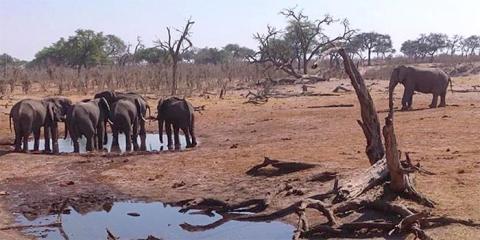Impacts from Elephants to Forests
December 09, 2014
My wife and I recently returned from a memorable trip to the southern part of the African continent visiting South Africa and Botswana. The first half of the trip was spent in the wild areas of Botswana, a Texas-sized country with only two million people.
Houston alone, has more people than that, so unlike many African countries, a stable population has allowed that country’s elected leaders to set aside nearly half of its landmass in wildlife conservation areas. Without human population pressures, wildlife thrives in Botswana’s wild areas. To access the camps, we landed on dirt airstrips where sometimes giraffes, buffalo and warthogs must first be cleared and the elephant dung swept away.
Make no mistake, elephant populations in Africa are in trouble, but not in Botswana. We saw hundreds of them every day at each of the three camps we visited. We were told that 200,000 roam the country. Poachers still manage to kill elephants for ivory – a problem readily admitted by locals – but the government is tough on poachers if they’re caught. But overall, elephants are thriving in Botswana.
To be blunt, however, you can’t miss the incredible impacts that these animals have on the landscape. We asked about this as we drove into our first camp. A full-grown elephant will eat 330-375 pounds of forage each day feeding for hours on end. They eat grasses, small plants, bushes, twigs, tree bark, roots and fruits.
At one camp, a very large bull elephant tore down the camp’s electric fences and wooden walkways to reach the lusher forage and especially the sweet palm nuts that shyer animals wouldn’t retrieve. – There is nothing shy about elephants. – At night, he’d shake the palm trees with his long tusks to knock them down. – That’s disturbing when you’re in a dark tent very close to a five-ton animal.
The landscape is highly affected by elephants: they dig soils to find needed minerals; they create wallows for mud, and their non-stop feeding makes the forest and woodlands look like a tornado stripped everything bare.
Our guides were unconcerned. We were assured that as soon as the dry season ended, that lots of foliage would reappear and the landscape would return to normal.
Whatever that is.
Today, we look at our own Pacific Northwest forests and woodlands and assume that they always looked something like they do today. But this area was home to elephant-like mammoths, mastodons and other mega-fauna before their extinction some 15,000 years ago. Scholarly papers on this subject posit that their absence triggered an explosion of woody biomass on the North American landscape and a wholesale reordering of the trees, shrubs and grasses that dominated ecosystems.
It makes me wonder what the African landscape would look like without these iconic animals and what ours would look like with them.
Dave Kvamme
